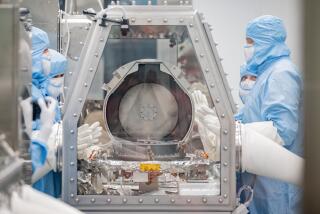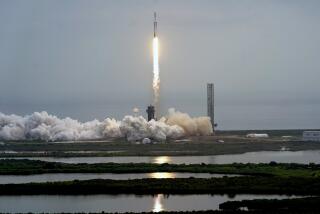Look up! You might see NASA’s asteroid-hunting spacecraft fly past Earth

At 9:52 a.m. Pacific, OSIRIS-REx (short for Origins, Spectral Interpretation, Resource Identification, and Security-Regolith Explorer) hits its closest point to Earth, 11,000 miles above Antarctica. (Sept. 22, 2017)
- Share via
It’s time to wave goodbye ... for now. This morning, NASA’s OSIRIS-REx is zipping past Earth on its way to the asteroid Bennu – the last time we’ll see the spacecraft until 2023.
At 9:52 a.m. Pacific, OSIRIS-REx (short for Origins, Spectral Interpretation, Resource Identification and Security-Regolith Explorer) hits its closest point to Earth, 11,000 miles above Antarctica. If you’re a well-positioned astronomer with a telescope, you might even catch a snapshot of the spacecraft flying by. Some are already charting its progress.
This maneuver isn’t just for show, though. As it flies by at about 19,000 miles per hour, the spacecraft is actually using Earth’s gravity to slingshot itself toward the asteroid.
Bennu lies in an orbital plane that’s 6 degrees off from Earth’s, so the spacecraft will have to dip below the southern pole in order to use Earth’s mass to lift it out of our own orbital plane and into the asteroid’s.
Once it passes Earth, OSIRIS-REx will power its instruments on and point them back toward Earth, catching a few views of its home planet and sending them back to its NASA handlers.
“We’ll have some small-level science but it’s primarily for us about instrument testing,” said Christina Richey, OSIRIS-REx deputy program scientist at NASA headquarters in Washington, D.C. “The whole goal is to make sure all the instruments are up and ready to go for rendez-vous.”
OSIRIS-REx, launched in September 2016, will be the first U.S. mission to gather samples of an asteroid and then return them to Earth. (The first was Japan’s Hayabusa spacecraft, sent to the asteroid Itokawa.) It’s set to reach Bennu in 2018 and send its precious cargo back to Earth in September 2023.
Asteroids are thought to be the leftover remnants from the solar system’s formation that never made it into a planet. Because they haven’t been dramatically altered by the heat and pressure inside a planet’s body, these rocks serve as space fossils that could tell us much about what our early solar system looked like, billions of years ago.
Among the asteroids, Bennu is an especially tempting target because it’s dark, covered in carbon-rich molecules that scientists think may represent some of the chemical building blocks of life. Many scientists think that it was likely an asteroid or a comet that brought the right ingredients for life to Earth — and bringing samples of an asteroid back to Earth could allow researchers to further probe that idea.
“By retrieving that sample, we’ll be able to see some of the precursor-to-life organic molecules,” Richey said.
Meteorites, many of which are thought to be chunks of asteroids that have fallen to Earth, have given us some insight into these bodies, but they’ve already been contaminated by Earth’s environment, Richey pointed out.
Pristine samples of an asteroid could be a game-changer for planetary scientists; after all, the Apollo mission’s lunar samples, gathered by astronauts from 1969 to 1972, are still being studied today, she said.
While 2023 may seem a long ways away, Richey said she’s already looking forward to it: The spacecraft is set to return to Earth on her birthday.
In the meantime, sky watchers can wave to the spacecraft today and post their photo on social media with the hashtag #HelloOSIRISREx, Richey said.
Follow @aminawrite on Twitter for more science news and “like” Los Angeles Times Science & Health on Facebook.
MORE IN SCIENCE
How soon can NASA go back to Saturn? This is what has to happen first
Pediatricians may view tattoos, piercings as red flags. They should discuss it instead, report says
Caltech scientists make robots out of DNA that can pick stuff up and move it around







